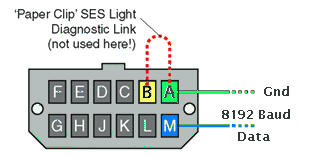

- ALDL INTERFACE CABLE SERIAL
- ALDL INTERFACE CABLE PRO
- ALDL INTERFACE CABLE SOFTWARE
- ALDL INTERFACE CABLE DOWNLOAD
When connected to a Thunderbolt device, the per-lane data rate becomes 10 Gbit/s and the four Thunderbolt lanes are configured as two duplex lanes, each 10 Gbit/s comprising one lane of input and one lane of output. When connected to a DP-compatible device, the Thunderbolt port can provide a native DisplayPort signal with four lanes of output data at no more than 5.4 Gbit/s per Thunderbolt lane. Thunderbolt is interoperable with DP-1.1a compatible devices. Ī single Mini DisplayPort monitor or other device of any kind may be connected directly or at the very end of the chain. A single Thunderbolt port supports up to six Thunderbolt devices via hubs or daisy chains as many of these as the host has DP sources may be Thunderbolt monitors. Thunderbolt controllers multiplex one or more individual data lanes from connected PCIe and DisplayPort devices for transmission via two duplex Thunderbolt lanes, then de-multiplex them for use by PCIe and DisplayPort devices on the other end.
ALDL INTERFACE CABLE PRO
Thunderbolt 2 port on MacBook Pro with Retina display. Thunderbolt 1 and 2 use the same connector as Mini DisplayPort (MDP), whereas Thunderbolt 3 and 4 reuse the USB-C connector from USB. Up to six peripherals may be supported by one connector through various topologies.
ALDL INTERFACE CABLE SERIAL
Thunderbolt combines PCI Express (PCIe) and DisplayPort (DP) into two serial signals, and additionally provides DC power, all in one cable. It was initially marketed under the name Light Peak, and first sold as part of an end-user product on 24 February 2011.

It has been developed by Intel, in collaboration with Apple. Thunderbolt is the brand name of a hardware interface for the connection of external peripherals to a computer.

HS1TX(P) of the source is connected to HS1RX(P) of the sink. The cable is actually a crossover cable, it swaps all receive and transmit lanes e.g. This is the pinout for both sides of the connector, source side and sink side. Thunderbolt 4: 4× PCI Express 3.0, DisplayPort 2.0, USB4 Thunderbolt 3: 4× PCI Express 3.0, DisplayPort 1.2 (2 streams), USB 3.1 gen. Thunderbolt 2: 4× PCI Express 2.0, DisplayPort 1.2 Thunderbolt 1: 4× PCI Express 2.0, DisplayPort 1.1a Thunderbolt 3: 40 Gbit/s bidirectional, 80 Gbit/s one way Thunderbolt 1: 2 channels, 10 Gbit/s each (20 Gbit/s in total) Q - Can I get a version of the 16 pin cable with the switchable 10K O resistor?Ī - No, GM never required the 10K ohm resistor on the 16 Pin OBD1 vehicles and thus my 16 Pin cable has none.Via DisplayPort protocol or USB-based external audio cards.

If you have questions on the 10K ohm resistor contact me. On MOST ECMs the 10K ohm resistor either does not affect the ECM operation, OR the 10K ohm resistor is needed for data flow. Q - Why would I want to disable the resistor?Ī - On a few select ECMs the 10K O resistor is not needed for the data flow but does alter the idle speed and timing. Q - Can I disable the 10K ohm A-B resistor?Ī - Yes the 10K resistor can be switched off on the 12 Pin version. Q - Does this cable include the 10K ohm A-B resistor needed on many 12 Pin 160 Baud ECMs?
ALDL INTERFACE CABLE DOWNLOAD
Q.- Will this work with my 94-95 6.5 Turbo-Diesel?Ī - Yes it will however you will have to download and use GMTD Scan Basic (free) or GMTD Scan Tech ($) from Make sure you order the cable that fits your cars connector. GM used 12 pin OBD1 type and 16 pin OBD2 type connectors on 94 & 95 vehicles. Q - Will this cable work with my 94/95 3800 OBD1.5?Ī - Yes it will.
ALDL INTERFACE CABLE SOFTWARE
There are 3 things needed to access the diagnostic data stream from a GM based On Board Diagnostic 1 ( OBD1 ) system on your 1982 - 1995 car or truck.ġ - A laptop PC with an available USB portģ - A software program running with the correct stream definition for your car or truck


 0 kommentar(er)
0 kommentar(er)
